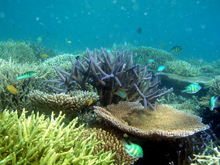Local Action Strategies
In 2002, the U.S. Coral Reef Task Force called for the development of Local Action Strategies (LAS) by each of the seven member U.S. states, territories, and commonwealths. These LAS are three-year, locally driven roadmaps for collaborative and cooperative action among federal, state, territory, and non-governmental partners. LAS identify and implement priority actions needed to reduce key threats to valuable coral reef resources.
The goals and objectives of the LAS are linked to those found in the U.S. National Action Plan to Conserve Coral Reefs, adopted by the U.S. Coral Reef Task Force in 2000. From the 13 goals identified in the National Action Plan, the Task Force prioritized six threat areas as the focus for immediate local action: overfishing, land-based sources of pollution, recreational overuse and misuse, lack of public awareness, climate change and coral bleaching, and disease.

Restoring and maintaining coral reefs to their healthy state requires carefully planning and coordination. Click image for larger view and image credit.
Florida, Hawaii, Guam, the U.S. Virgin Islands, American Samoa, Puerto Rico, and the Commonwealth of the Northern Mariana Islands created specific LAS for select locally relevant threats, using the six priority focus areas as a guide. Additional focus areas were identified in some jurisdictions including: invasive species in Hawaii, population pressure in American Samoa, and maritime industry and coastal construction impacts in Florida. Applying a collaborative decision-making process based on local needs, concerns, and capacities, each jurisdiction developed strategies that contain a variety of projects designed for implementation over a three-year period.
To Date
The Local Action Strategies developed thus far go beyond the efforts of government agencies to include the views and voices of hundreds of stakeholders, including representatives of local and international non-governmental organizations, academia, industry, and concerned citizens. These views were expressed through extensive workshops, briefings, and public meetings.
While the approach to LAS development was unique in each jurisdiction, all of the resultant strategies include targeted goals, objectives, and specific projects to reduce focus area threats. Currently, resources are being identified and acquired to implement the strategies. As additional capacity and funding become available in the future, it is anticipated that new strategies addressing the remaining focus areas in the National Action Plan will be initiated as relevant to each jurisdiction.
As of 2006, the LAS effort has involved thousands of stakeholders, identified 700 priority projects, over 400 of which are currently underway. Over $24 million has been raised from governmental and non-governmental sources for funding these priority projects (40 percent of the total need), and $37 million more is needed for full implementation.
Conclusion
The LAS framework has allowed U.S Coral Reef Task Force agencies to more clearly identify local needs, connect local priorities to national goals, and coordinate agency actions to better support each local jurisdiction’s management of their coral resources. Local leadership and commitment are the foundation of the LAS efforts. However, a great deal of work remains in identifying support to implement the LAS during the upcoming years.
